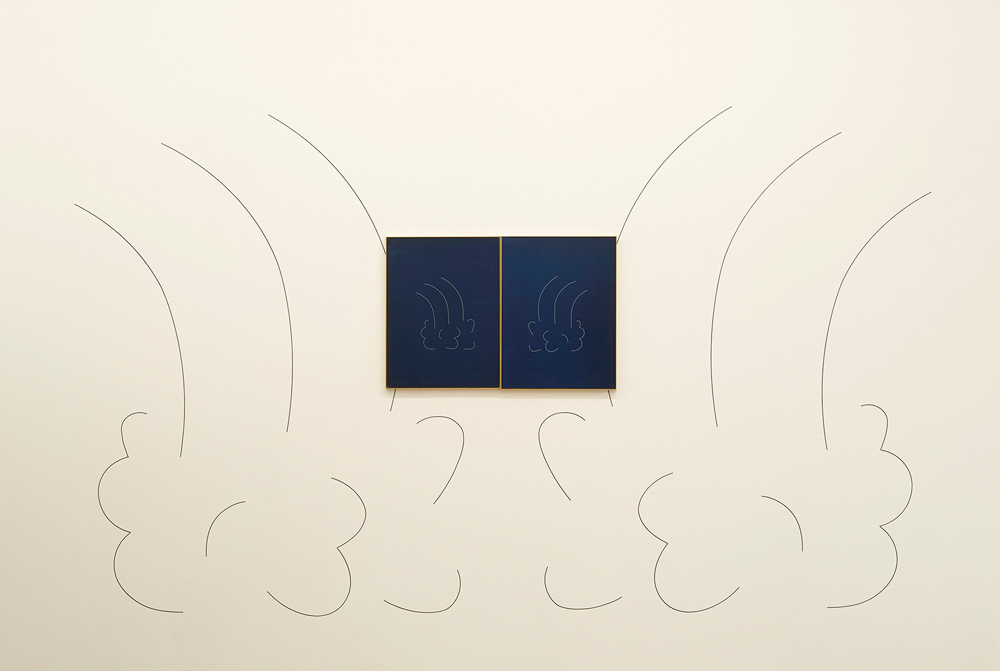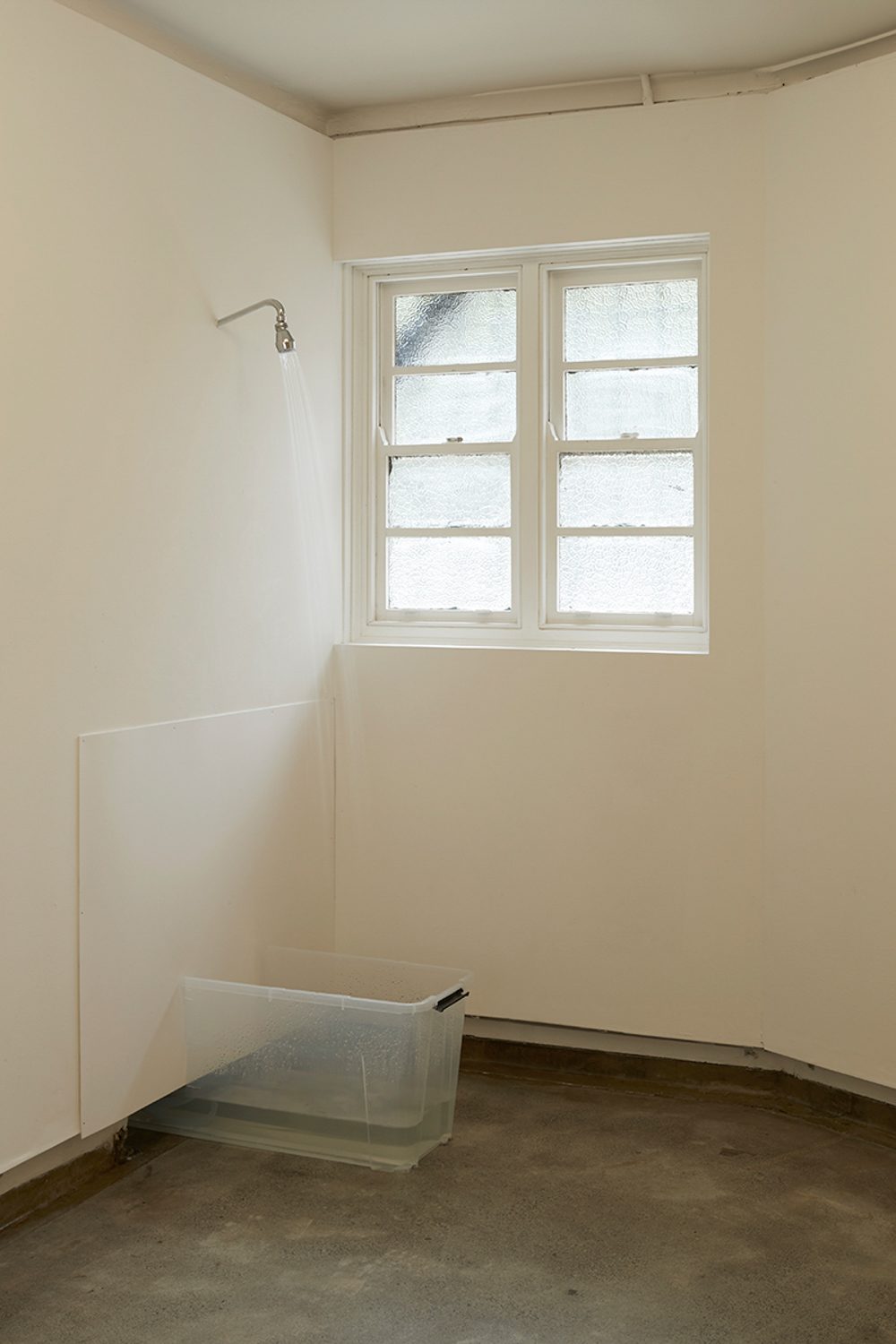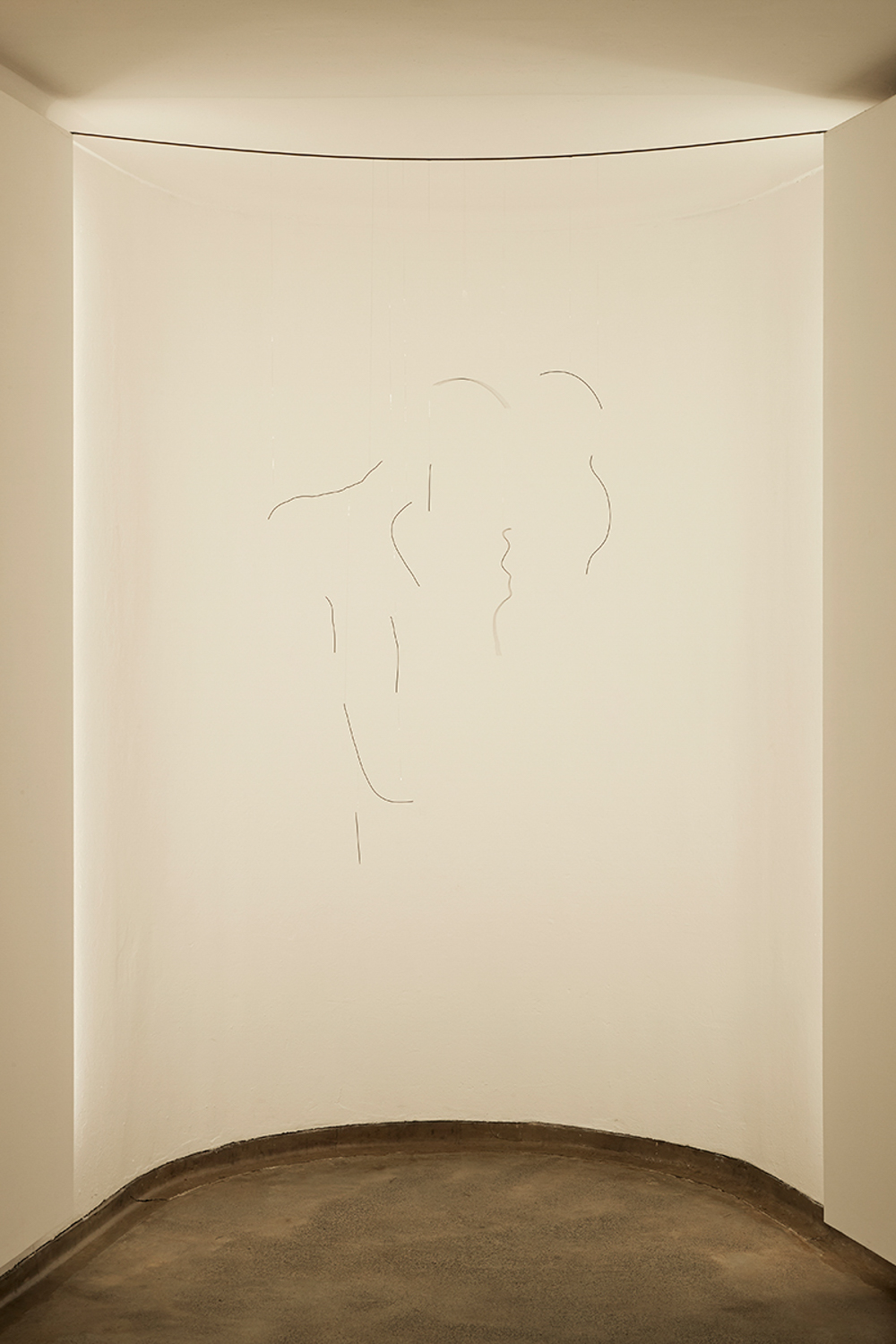it’s hard to move away from turning water

By Naomi Riddle
23 November, 2018
‘Drawing on the writing of Lyn Hejinian, [this exhibition] takes a boxed archive of 35mm slides stored within a pebblecrete shower cubicle as an allegorical site from which to contemplate the fluidity of forms as they are presented, viewed and recalled across time. Via sculpture, cyanotype, mobiles and de-silvered mirrors, imagery drawn from within the slide archive is fragmented, transposed and re-composed.’1

Tom Blake, it’s hard to move away from turning water (2018), installation view
Image credit: Zan Wimberley
it is hard to turn away from moving water
We arrive in the middle/ the shower is already running.
Something has happened before (the faucet has been turned on), and something will happen after (the faucet will be turned off), but, for now, we are ‘in the meantime’: ensnared, paused, on the threshold.
In this looping present, the sequences of causality no longer hold: a plastic bucket is being filled and emptied, although the volume of liquid doesn’t change/ water cycles in and around itself, up the spout/ out of the spout (repeat).
Time is an electronic river/ but this river’s current is a circle.
loop (n.)
late 14c., ‘a fold or doubling of cloth, rope, leather, cord, etc.,’ of uncertain origin. OED favours a Celtic origin (compare Gaelic lub ‘bend’, Irish lubiam), which in English was perhaps influenced by or blended with Old Norse hlaup, ‘a leap, run’.
the ‘open text’ often emphasises or foregrounds process, either the process of the original composition or of subsequent compositions
When looking at each of Blake’s works we think of their original: the 35mm slides in their contained box in their pebblecrete shower. But the original is off-stage and, for us, unknown. As such, the imagery remains open as a text remains open: meaning is permeable in that the lines and tracings are hinges for meaning rather than meaning itself.
(if the water is the loop, then Blake’s lines are the loop’s etymological second cousin: the leap)
The lines on each surface, and the lines suspended from the ceiling via lurex thread, form a choreography of implied gesture/ a turn, an incision, a graze, a scrape, a score (a notch cut into the surface and also the written representation of a composition).
We sketch out movement by watching a dancer’s lines: a pointed toe or thrown forearm allowing us to discern whether a gesture is joyous or hungry or pained or desiring. In the same way, we decipher the imprint of a line by the length of its curve—we read it as beckoning, pointing, repelling, flying, supporting, flattening, or enclosing.

Tom Blake, it’s hard to move away from turning water (2018), installation view
Image credit: Zan Wimberley
What do we see in Blake’s lines?
a bod
y that
kneels
the post-
erior
arch
a tilt
ed head
on a
granite
column
shoulder
blade
hanging
limbs
the boughs
of trees
& a
tenta
tive em
brace or
a tent
ative
refus
al an
eager
tear
falling
steam
clasped
hands
set against (held against) the firmament:
the negative space of a cyanotype
or a mirror
or a gallery wall.
hold back, as less from friends; hold the book, hold up, then hold on tight, hang on.
Blake’s titles suggest repetitive motion in the perfect continuous: ‘stream[ing]’, ‘holding’, ‘moving [but] in circles’, ‘bend[ing]’ and ‘turning to stone’. This is a being in the not-yet: a being inside the state of becoming: a being in a state of arrestment before arrival. We have momentum (with the leap), which stalls (with the loop): the obvious analogy is with music.
Even the stated endpoint—a stone (towards which some of Blake’s lines turn)—in all its rigidity, still moves: the pebble embeds itself in the sole of a shoe and travels; distance is measured by the length the stone is thrown.
Tracing the slide-image deviates from drawing
or painting or (re)photographing the slide-image.
It shadows its original form,
but loosens the boundaries.
It works with erasure,
but still covets presence.
ruptures or disjunctions are markers of feelings which are beyond speech and Blake is asking for feeling to be felt through the gap/ inside the field of energy created between two bended lines, which, if not marked, or tethered by wire, might instantly spring apart.
only fragments are accurate.
Works cited in italics:
Lyn Hejinian, My Life, (Los Angeles: Sun & Moon Press, 1987)
Hejinian, The Language of Inquiry, (Berkeley: University of California Press, 2000)
Hejinian, ‘I am suddenly aware that phrases happen’ [interview with Al Filreis], Jacket2 (22/02/05)